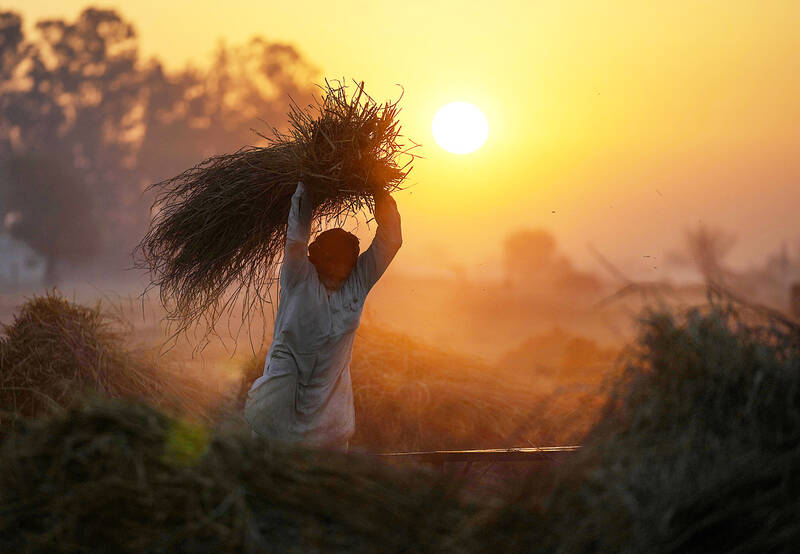Iron ore last week rose to the highest level in almost four months on signs that Chinese authorities would announce more support for the property sector at a key meeting next week.
Futures advanced in Singapore on Friday, extending a rally from a 45-month low at the end of October to almost 50 percent.
The steelmaking ingredient has been buoyed by a steady stream of policies favorable to the real-estate industry in the world’s most-populous nation.

Photo: AP
Traders are banking on hopes that the property sector, good for 40 percent of China’s steel consumption, would get more support at the Chinese Central Economic Work Conference scheduled for next week, at which policymakers are to discuss goals for the new year.
Authorities aim to reverse the downward trend in the sector and resume normal operations, a person familiar with the matter said.
There is scope for iron ore to rally further due to positive sentiment on China’s shift away from its “zero COVID-19” policy and Beijing’s determination to support the property sector, Citigroup Inc said in a note.
The bank increased its three-month forecast to US$120 a tonne and said prices could climb toward US$150 if China announces meaningful credit easing over the next three to six months or the re-opening accelerates.
Replenishment of iron ore stockpiles remains slower than expected, Minmetals Futures said in a note.
That should help keep prices robust in the short term, it said.
Iron ore rose 2 percent to US$111.25 a tonne in Singapore on Friday, set for a sixth weekly advance. Futures in Dalian, China, climbed 3.1 percent, as steel rebar and hot-rolled coil advanced in Shanghai.
Meanwhile, wheat posted a fifth straight week of losses as prospects brighten for getting global grain shipments out of the war-stressed Black Sea.
The US Department of Agriculture raised its outlook for world wheat trade in part on higher exports from Ukraine and Russia, the agency said in its monthly World Agricultural Supply and Demand Estimates on Friday.
Last month’s extension of a Russia-Ukraine agreement allowing for safe passage of exports from the Black Sea has helped cool off recent price gains, potentially easing a scourge of global food inflation.
A bumper wheat crop in Australia is also sending prices lower.
Despite earlier fears that flooding in parts of eastern Australia would hurt grain quality, reports indicate its not “the nightmare it looked like it could be just last month,” Frontier Futures broker Joe Nussmeier said.
Further pressuring prices is a forecast for beneficial rains in wheat producing US states such as Kansas, said Rich Nelson, chief strategist at commodity brokerage Allendale Inc.
The most active wheat contract in Chicago closed 1.6 percent lower at US$7.3425 a bushel on Friday, while corn gained slightly an soybeans fell.
Other commodities:
Gold for February delivery rose US$9.20 to US$1,810.70 an ounce, posting a marginal weekly gain of 0.06 percent.
Silver for March delivery rose US$0.47 to US$23.72, up 1.99 percent from a week earlier
Copper for delivery in March was unchanged at US$3.88 a pound.
Additional reporting by AP

UNCERTAINTY: Innolux activated a stringent supply chain management mechanism, as it did during the COVID-19 pandemic, to ensure optimal inventory levels for customers Flat-panel display makers AUO Corp (友達) and Innolux Corp (群創) yesterday said that about 12 to 20 percent of their display business is at risk of potential US tariffs and that they would relocate production or shipment destinations to mitigate the levies’ effects. US tariffs would have a direct impact of US$200 million on AUO’s revenue, company chairman Paul Peng (彭雙浪) told reporters on the sidelines of the Touch Taiwan trade show in Taipei yesterday. That would make up about 12 percent of the company’s overall revenue. To cope with the tariff uncertainty, AUO plans to allocate its production to manufacturing facilities in

TAKING STOCK: A Taiwanese cookware firm in Vietnam urged customers to assess inventory or place orders early so shipments can reach the US while tariffs are paused Taiwanese businesses in Vietnam are exploring alternatives after the White House imposed a 46 percent import duty on Vietnamese goods, following US President Donald Trump’s announcement of “reciprocal” tariffs on the US’ trading partners. Lo Shih-liang (羅世良), chairman of Brico Industry Co (裕茂工業), a Taiwanese company that manufactures cast iron cookware and stove components in Vietnam, said that more than 40 percent of his business was tied to the US market, describing the constant US policy shifts as an emotional roller coaster. “I work during the day and stay up all night watching the news. I’ve been following US news until 3am

COLLABORATION: Given Taiwan’s key position in global supply chains, the US firm is discussing strategies with local partners and clients to deal with global uncertainties Advanced Micro Devices Inc (AMD) yesterday said it is meeting with local ecosystem partners, including Taiwan Semiconductor Manufacturing Co (TSMC, 台積電), to discuss strategies, including long-term manufacturing, to navigate uncertainties such as US tariffs, as Taiwan occupies an important position in global supply chains. AMD chief executive officer Lisa Su (蘇姿丰) told reporters that Taiwan is an important part of the chip designer’s ecosystem and she is discussing with partners and customers in Taiwan to forge strong collaborations on different areas during this critical period. AMD has just become the first artificial-intelligence (AI) server chip customer of TSMC to utilize its advanced

Six years ago, LVMH’s billionaire CEO Bernard Arnault and US President Donald Trump cut the blue ribbon on a factory in rural Texas that would make designer handbags for Louis Vuitton, one of the world’s best-known luxury brands. However, since the high-profile opening, the factory has faced a host of problems limiting production, 11 former Louis Vuitton employees said. The site has consistently ranked among the worst-performing for Louis Vuitton globally, “significantly” underperforming other facilities, said three former Louis Vuitton workers and a senior industry source, who cited internal rankings shared with staff. The plant’s problems — which have not